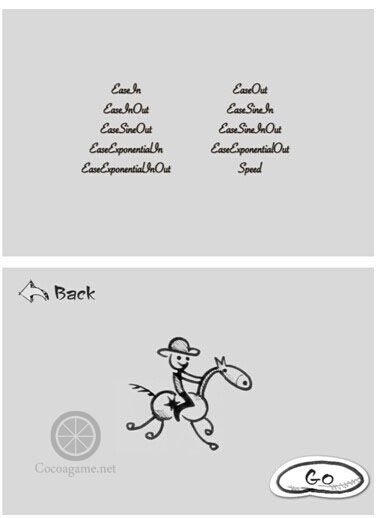Cocos2d-x如何控制动作速度
基本动作和组合动作实现了针对精灵的各种运动和动画效果的改变。但这样的改变速度匀速的、线性的。通过ActionEase及其的派生类和Speed 类我们可以使精灵以非匀速或非线性速度运动,这样看起了效果更加逼真。
ActionEase的类图如下图所示。
下面我们通过一个实例介绍一下这些动作中速度的控制的使用,这个实例如下图所示,上图是一个操作菜单场景,选择菜单可以进入到下图动作场景,在下图动作场景中点击Go按钮可以执行我们选择的动作效果,点击Back按钮可以返回到菜单场景。
下面我们再看看具体的程序代码,首先看一下看HelloWorldScene.h文件,它的代码如下:
#ifndef __HELLOWORLD_SCENE_H__
#define __HELLOWORLD_SCENE_H__
#include "cocos2d.h"
#include "MyActionScene.h"
typedef enum ①
{
kEaseIn = 1
,kEaseOut
,kEaseInOut
,kEaseSineIn
,kEaseSineOut
,kEaseSineInOut
,kEaseExponentialIn
,kEaseExponentialOut
,kEaseExponentialInOut
,kSpeed
} ActionTypes; ②
class HelloWorld : public cocos2d::Layer
{
public:
static cocos2d::Scene* createScene();
virtual bool init();
void OnClickMenu(cocos2d::Ref* pSender);
CREATE_FUNC(HelloWorld);
};
#endif // __HELLOWORLD_SCENE_H__
上述代码第①~②是定义个枚举类型ActionTypes,枚举类型ActionTypes中定义了10个常量,这10个常量对应10个菜单项。
HelloWorldScene的实现代码HelloWorldScene.ccp文件,它的主要代码如下:
bool HelloWorld::init()
{
if( !Layer::init() )
{
returnfalse;
}
SizevisibleSize = Director::getInstance()->getVisibleSize();
Pointorigin = Director::getInstance()->getVisibleOrigin();
autobg = Sprite::create("background.png");
bg->setPosition(Point(visibleSize.width/2,visibleSize.height /2));
this->addChild(bg);
autopItmLabel1 = Label::createWithBMFont("fonts/fnt2.fnt","EaseIn");
autopItmMenu1 = MenuItemLabel::create(pItmLabel1,
CC_CALLBACK_1(HelloWorld::OnClickMenu, this));
pItmMenu1->setTag(kEaseIn);
autopItmLabel2 = Label::createWithBMFont("fonts/fnt2.fnt","EaseOut");
autopItmMenu2 = MenuItemLabel::create(pItmLabel2,
CC_CALLBACK_1(HelloWorld::OnClickMenu,this));
pItmMenu2->setTag(kEaseOut);
autopItmLabel3 = Label::createWithBMFont("fonts/fnt2.fnt","EaseInOut");
autopItmMenu3 = MenuItemLabel::create(pItmLabel3,
CC_CALLBACK_1(HelloWorld::OnClickMenu,this));
pItmMenu3->setTag(kEaseInOut);
autopItmLabel4 = Label::createWithBMFont("fonts/fnt2.fnt","EaseSineIn");
autopItmMenu4 = MenuItemLabel::create(pItmLabel4,
CC_CALLBACK_1(HelloWorld::OnClickMenu,this));
pItmMenu4->setTag(kEaseSineIn);
autopItmLabel5 = Label::createWithBMFont("fonts/fnt2.fnt", "EaseSineOut");
autopItmMenu5 = MenuItemLabel::create(pItmLabel5,
CC_CALLBACK_1(HelloWorld::OnClickMenu,this));
pItmMenu5->setTag(kEaseSineOut);
autopItmLabel6 = Label::createWithBMFont("fonts/fnt2.fnt","EaseSineInOut");
autopItmMenu6 = MenuItemSprite::create(pItmLabel6,
CC_CALLBACK_1(HelloWorld::OnClickMenu,this));
pItmMenu6->setTag(kEaseSineInOut);
autopItmLabel7 = Label::createWithBMFont("fonts/fnt2.fnt","EaseExponentialIn");
autopItmMenu7 = MenuItemSprite::create(pItmLabel7,
CC_CALLBACK_1(HelloWorld::OnClickMenu,this));
pItmMenu7->setTag(kEaseExponentialIn);
autopItmLabel8 = Label::createWithBMFont("fonts/fnt2.fnt","EaseExponentialOut");
autopItmMenu8 = MenuItemLabel::create(pItmLabel8,
CC_CALLBACK_1(HelloWorld::OnClickMenu,this));
pItmMenu8->setTag(kEaseExponentialOut);
autopItmLabel9 = Label::createWithBMFont("fonts/fnt2.fnt","EaseExponentialInOut");
autopItmMenu9 = MenuItemLabel::create(pItmLabel9,
CC_CALLBACK_1(HelloWorld::OnClickMenu,this));
pItmMenu9->setTag(kEaseExponentialInOut);
autopItmLabel10 = Label::createWithBMFont("fonts/fnt2.fnt","Speed");
autopItmMenu10 = MenuItemLabel::create(pItmLabel10,
CC_CALLBACK_1(HelloWorld::OnClickMenu,this));
pItmMenu10->setTag(kSpeed);
automn = Menu::create(pItmMenu1,pItmMenu2,pItmMenu3,pItmMenu4,pItmMenu5,
pItmMenu6,pItmMenu7,pItmMenu8,pItmMenu9,pItmMenu10,NULL);
mn->alignItemsInColumns(2,2, 2, 2, 2, NULL);
this->addChild(mn);
returntrue;
}
void HelloWorld::OnClickMenu(Ref* pSender)
{
MenuItem*nmitem = (MenuItem*)pSender;
auto sc = Scene::create();
auto layer = MyAction::create();
layer->setTag(nmitem->getTag());
sc->addChild(layer);
autoreScene = TransitionSlideInR::create(1.0f, sc);
Director::getInstance()->replaceScene(reScene);
}
在上诉代码大家比较熟悉了,我们这里就不再介绍了。下面我们再看看下一个场景MyActionScene,它的MyActionScene.ccp,它的主要代码如下:
void MyAction::goMenu(Ref* pSender)
{
log("Tag = %i",this->getTag());
FiniteTimeAction * ac1 = (FiniteTimeAction *)MoveBy::create(2,Point(200, 0));
FiniteTimeAction * ac2 = ((FiniteTimeAction *)ac1)->reverse();
ActionInterval * ac = Sequence::create(ac1, ac2, NULL);
switch (this->getTag()) {
case kEaseIn:
sprite->runAction(EaseIn::create(ac, 3)); ①
break;
case kEaseOut:
sprite->runAction(EaseOut::create(ac, 3)); ②
break;
case kEaseInOut:
sprite->runAction(EaseInOut::create(ac,3)); ③
break;
case kEaseSineIn:
sprite->runAction(EaseSineIn::create(ac)); ④
break;
case kEaseSineOut:
sprite->runAction(EaseSineOut::create(ac)); ⑤
break;
case kEaseSineInOut:
sprite->runAction(EaseSineInOut::create(ac)); ⑥
break;
case kEaseExponentialIn:
sprite->runAction(EaseExponentialIn::create(ac)); ⑦
break;
case kEaseExponentialOut:
sprite->runAction(EaseExponentialOut::create(ac)); ⑧
break;
case kEaseExponentialInOut:
sprite->runAction(EaseExponentialInOut::create(ac)); ⑨
break;
case kSpeed:
sprite->runAction(Speed::create(ac, (CCRANDOM_0_1() * 5))); ⑩
break;
}
}
第①行代码sprite->runAction(EaseIn::create(ac, 3))是以3倍速度由慢至快。第②代码sprite->runAction(EaseOut::create(ac, 3))是以3倍速度由快至慢。第③代码sprite->runAction(EaseInOut::create(ac, 3))是以3倍速度由慢至快再由快至慢。
第④代码sprite->runAction(EaseSineIn::create(ac))是采用正弦变换速度由慢至快。第⑤代码sprite->runAction(EaseSineOut::create(ac))是采用正弦变换速度由快至慢。第⑥代码sprite->runAction(EaseOut::create(ac, 3)) 是采用正弦变换速度由慢至快再由快至慢。
第⑦代码sprite->runAction(EaseExponentialIn::create(ac))采用指数变换速度由慢至快。第⑧代码sprite->runAction(EaseExponentialOut::create(ac))采用指数变换速度由快至慢。第⑨代码sprite->runAction(EaseExponentialInOut::create(ac)) 采用指数变换速度由慢至快再由快至慢。
第⑩代码sprite->runAction(Speed::create(ac, (CCRANDOM_0_1() * 5))) 随机设置变换速度。
京东:http://item.jd.com/11584534.html
亚马逊:http://www.amazon.cn/Cocos2d-x%E5%AE%9E%E6%88%98-C-%E5%8D%B7-%E5%85%B3%E4%B8%9C%E5%8D%87/dp/B00PTYWTLU
当当:http://product.dangdang.com/23606265.html
互动出版网:http://product.china-pub.com/3770734
《Cocos2d-x实战 C++卷》源码及样章下载地址:
源码下载地址:http://51work6.com/forum.php?mod=viewthread&tid=1155&extra=page%3D1
样章下载地址:http://51work6.com/forum.php?mod=viewthread&tid=1157&extra=page%3D1


